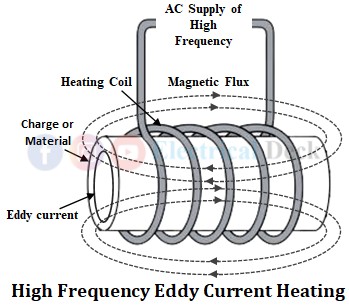The eddy current heating is the process of heating the charge by inducing eddy currents in it. In this method, the charge or material to be heated is placed inside a current-carrying coil that induces an eddy current in the charge, due to which heat is produced and the temperature of the charge is increased. For eddy current heating the input current supplied is of high frequency hence the method is also called high-frequency eddy current heating.
Eddy Current Heating :
The below diagram shows the arrangement of high-frequency eddy current heating. The charge or material to be heated is surrounded by a coil through which alternating current at high frequency is supplied. This current-carrying coil is known as a heater coil or work coil and is magnetically coupled with the charge to be heated.
Working of Eddy Current Heating :
When the coil is connected across a high-frequency ac supply, it setups an alternating magnetic flux due to which eddy currents are induced in the charge. This eddy current loss in the charge will generate heat in the charge thereby increasing the temperature of the charge.
The heat produced in the charge is mostly due to eddy current loss, but to some extent, hysteresis loss also contributes to the production of heat in charge in the case of magnetic material. The eddy current loss caused by eddy currents in a magnetic material is given by,
From the above equation, it can be seen that eddy current loss is proportional to the square of the supply frequency and magnetic flux density i.e., Pe ∝ f2 B2. Therefore by controlling the frequency and flux density, the heat produced in the charge can be controlled.
But the magnitude of eddy current induced in the charge will be large at the surface of the charge and goes on decreasing as we go inside the charge. Thus the eddy current loss i.e., the heat produced, will be high at the surface of the charge and low at the center. The depth up to which the eddy currents are induced in the charge can be known by,
Where,- ρ = Resistivity of charge.
- f = supply frequency.
- μr = Relative permeability of charge.
Since the depth of penetration of eddy currents into the charge is inversely proportional to the square root of the supply frequency. Therefore using eddy current heating, the depth of heat produced in the charge can also be controlled by judicious selection of frequency of the supplied current. A frequency in the range of 10 kHz to 40 kHz is used for eddy current heating.


